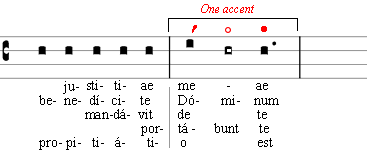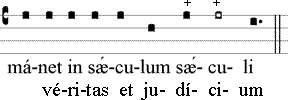
| LESSONS
ON GREGORIAN CHANT |
| GREGORIAN CHANT PSALMODY
Psalmody is meant to be the chant of the psalms and canticles of the Church. Verses and hemistiches: The psalms are composed of verses and each verse is made up of two hemistiches, separated to each other by an asterisk (*). If the first hemistich has a considerable extension, it admits the flexa that is indicated by a cross (†). Parátum cor ejus speráre in Dómino, † confirmátum est cor ejus * non commovébitur donec despíciat inimicos suos. Díxit Dóminus Dómino meo: * sede a dextris meis. Each of the eight modes has their special formula that is repeated in each verse. The psalm must be sung in the same mode of the antiphon that accompanies him. A complete psalmodic formula consists of:
However, in Magnificat, Benedictus and Nunc dimittis canticles, each verse begins with the intonation although for the verses Quod parasti of the Nunc dimittis, Requiem aeternam and Et lux of deceased office, for being too brief, intonation is not made. When several psalms are sung with a single antiphon, the intonation will be given at the beginning of each one of them, whenever they finish with the Gloria Patri. Intonation for the eight modes:
The first verse of Magnificat has special intonation in the modes 2nd and 8th.
Formulas for terminations: The different intonations of the antiphons have given place to the diverse final cadences in each mode, in order to facilitate the intonation of the antiphon, when psalm ends. The termination of each particular case is indicated in two ways:
8c
1 D2
8c

Classification of cadences according to the accent: They can be of one accent or of two. Cadences of one accent are those in whose melodic formula the last main or secondary accent are adapted.
Cadences of two accents are those in
whose melodic formula the last two main or secondary accents are
adapted (
Both the medians and the terminations can be of one accent or of two. The flexa is always of one accent. NOTE: The interval
corresponding to the flexa is of one tone; only when the dominant
or tenor is immediately on the semitone, the interval is of one
tone and a half. That is to say, with dominant a or d,
the flexa has a one tone interval; and with dominant c or
f is of one tone and a half.
 Flexa of one tone and a half Pragmatic rules to distinguish the cadences of one accent and of two accents: The cadence of one accent that is the shortest has for foundation the paroxytone word, for example lége (' •); and it necessarily consists of two essentials notes: the first one accented —melodic accent—; and the second one unstressed.
The accent can go preceded of one or more preparation notes:
The first preparation note is always inferior to the tenor, except the median —named solemn— of the fifth mode, and that of the paschal mode. The cadence of two accents has like foundation the double paroxytone word, for example córde meo. It always includes four essentials notes: two accented, followed each of them by one unstressed.
All cadence of two accents needs four notes different from the tenor; of those, the first —melodic accent—, is upper than the tenor. This cadence never has preparation notes.
Rules to distinguish the two classes of cadences:
The proparoxytone words in the cadences: When the cadences have proparoxytone words, a note that corresponds usually (there are some exceptions) to the penultimate syllable of this class of words is added, for each accent. This syllable is represented previously by the white note. The note of this penultimate syllable of the proparoxytone words is usually after the accent.
In the cadences whose penultimate place goes occupied by a clivis, the white note —which is before this neume— corresponds to the accented syllable and the clivis corresponds to the penultimate one. The added note, in this last case, is named as premature note of accent.
The penultimate syllable of the proparoxytone word is sung to the unison with the following one.
Exceptions of this rule (it is executed to the unison with the previous one) are: the last accent in the 7th mode and, in general, all last accent that proceeds for interval of a descending semitone.
The premature note of the accent follows the general rule. Adaptation of the hemistiches of few syllables: When the text is too short and there are more notes than syllables in the cadences, have in mind the following rules:
b) Termination: only the number of notes corresponding to the number of syllables are used, making always coincide the accent of the text with the last melodic accent:
How to sing the cadences: When you go from the tenor to the cadences it should be controlled lightly the movement so that it can be considered that the tenor has been written as reciting and the cadences as singing. This slight movement change, practiced with discretion, gives to the psalmody a special charm and a pleasant variety. Relieve the accents, elevating them with grace and reinforcing the voice a little in the accented syllables. It should be avoided to give bigger intensity to the last syllable of the cadences as well as the precipitation of the previous syllables. NOTE: In many chant books, the syllables corresponding to the accents of the cadences, are written in bold characters while the preparation syllables are in italic characters.
The pauses of the cadences: In the case of the flexa, the complete value should be given to the note with point (two simple times) and it should be tried not to make pause. The pause of the median will be that of a simple time as it corresponds to the value of the biggest dividing line.
Tessitura: In the chant of the psalms of the Divine Office, it is convenient that the dominant in all the modes be at the same melodic level.
The election of the tessitura or melodic level depends on the singers. The A of the pitch is frequently the melodic grade adapted for the recitative note of the psalms. As for the antiphon that accompanies the psalm, their dominant note must coincide with the elected note for the tenor of the psalm, and with relationship to this dominant is elected the tone. This operation will be repeated whenever, finished a psalm and repeated its antiphon, a new antiphon must begin. Example: Domínica ad Vésperas 7 c2 In this case, if A is the note of the recitative of the psalm, given with the diapason, in her the dominant D shall be sung in the seventh mode to which belongs the 1st antiphon of vespers and, therefore, its corresponding psalm.
From the conventional D you will descend to the B —first note of the melody— and, begun the antiphon, the psalm will be intoned. Repeated the antiphon, after concluding the psalm, the same operation will be made for the following antiphon Magna opera Dómini, considering in this case the A of the pitch as a C —the dominant note in the third mode, in which this antiphon is written—. 3b
GENERAL DESCRIPTION OF THE PSALMS First mode
Second mode
Third mode
Fourth mode
Fourth mode, dominant D
Fifth mode
Sixth mode
Seventh mode
Eighth mode
“Peregrinus” Tone First verse
For the other verses
Tone “in directum”
Solemn or adorned Medians
Exercises: The following exercises will consist respectively on the chant of the psalms 111 and 112 in 3rd and 4th modes of Dominica ad vesperas. Please Indicate in them the intonation, the tenor, the flexa, the median and the termination. Discover if the cadences are of one or of two accents, if they have preparation notes, etc.
(1) The Monastery of Christ in the Desert http://www.christdesert.org/noframes/chant/psalms.html |
|||||||||||||||||||||||||||||||||||||||||||||||||||||||||||||||||||||||||||||||||||||||||||||||||||||||||||||||||||||||||||||||||||
![]()
Theory
and Technic | Canticum
Novum | Didactic
Concerts |
Links
History | Characteristics
| Notation | Modes
| Rhythm | Chironomy
| The psalmody |
| Latin pronuntiation |
Translations & scores|
Bogotá/Colombia - 2002







































































































